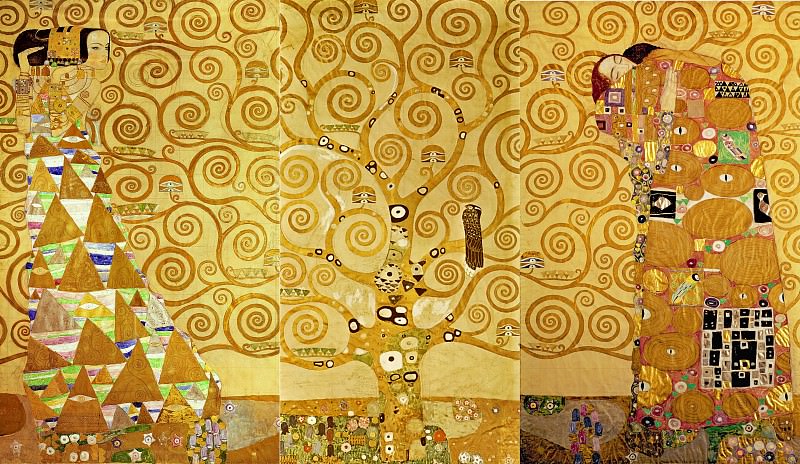Mural for the dining room of the Stoclet Palais: Expectation – Tree of life – Fulfilment Gustav Klimt (1862-1918)
Gustav Klimt – Mural for the dining room of the Stoclet Palais: Expectation - Tree of life - Fulfilment
Edit attribution
Download full size: 4486×2600 px (5,7 Mb)
Painter: Gustav Klimt
Location: Austrian Museum of Applied Arts, Vienna (Österreichisches Museum für angewandte Kunst, MAK).
The creation of this painting is associated with the name of the tycoon Adolf Stokwe, who in 1904 decided to build a huge family home. It was the fashion at the time to paint on and inside buildings, so the Viennese industrialist invited several artists (among them Gustav Klimt), offering them a contract. The industrialist was fond of Japanese art, so Klimt decided to paint an appropriate painting that would complement the overall design.
Description of Gustav Klimt’s The Tree of Life
The creation of this painting is associated with the name of the tycoon Adolf Stokwe, who in 1904 decided to build a huge family home. It was the fashion at the time to paint on and inside buildings, so the Viennese industrialist invited several artists (among them Gustav Klimt), offering them a contract.
The industrialist was fond of Japanese art, so Klimt decided to paint an appropriate painting that would complement the overall design. This resulted in the famous "Tree of Life" consisting of three elements - expectation, ecstasy and the tree of life itself.
The name carries a symbolic meaning and encourages the viewer to think: perhaps the artist tried to depict a biblical tree of the mind or to illustrate the genealogical tree of all mankind. The branches of the tree can be attributed to the symbol of infinity - the branches meet and intertwine with each other, creating a veritable maze of leaves and unusual scenery.
More attentive viewers may find a large number of triangles, squares and ovals. Experts say that these symbols in Japan are considered masculine and feminine. Europeans associate these symbols with the works of Sigmund Freud (it’s worth noting that Klimt read his work). Who knows, maybe it was the great Freud who inspired the artist to create such an unusual painting.
Klimt spent more than 6 years in his studio working on the golden tree, the central symbol of the painting. It was not in vain that the artist turned to the color gold, which symbolizes life. This is the main color of the picture, the rest perform the role of appendages to the golden tree. Actually, you could write the whole book, not a separate article, about the symbolism of the painting, so we limited ourselves to the central symbols. And there is no single correct explanation of the painting, everyone understands it in his own way.
Кому понравилось
Пожалуйста, подождите
На эту операцию может потребоваться несколько секунд.
Информация появится в новом окне,
если открытие новых окон не запрещено в настройках вашего браузера.
You need to login
Для работы с коллекциями – пожалуйста, войдите в аккаунт (open in new window).

















COMMENTS: 2 Ответы
Оригинально. Просто шикарно. Мне очень нравится. Попробую так нарисовать. Респект.
Zdravstvuyte, kak mojno skachat s maksimalnim razmerom?
You cannot comment Why?
Gustav Klimts Mural for the dining room of the Stoclet Palais: Expectation - Tree of life - Fulfilment is a three-part mosaic artwork characterized by an overwhelming use of gold and intricate patterns.
On the left, titled Expectation, a richly adorned female figure stands, her triangular-patterned robe a mosaic of geometric shapes in shades of gold, green, blue, and white. She is crowned and appears to be holding a floral or ornate object above her head. Her profile is turned, gazing upwards, suggesting anticipation.
The central panel, the Tree of Life, is the most dynamic. A stylized, golden tree with a thick trunk and sprawling branches dominates the composition. Swirling, spiral motifs fill the background, creating a sense of cosmic energy or movement. The tree is adorned with circular fruits or ornaments, some resembling eyes, and a prominent owl perched on one of its branches. The base of the tree is grounded with a mosaic of small floral and geometric elements. This panel symbolizes growth, connection, and cosmic order.
On the right, Fulfilment, depicts a couple locked in an embrace. Their bodies merge into a single, intricately patterned form. The male figure, largely obscured, supports the female, whose head is tilted back in repose or ecstasy. Their robes are a riot of gold, embellished with circles, squares, and eye-like motifs, echoing the patterns of the tree and the background. This panel represents union, climax, and spiritual or sensual satisfaction.
Subtexts:
The mural delves into themes of life, love, and spirituality. The Tree of Life is a universal symbol of existence, connection, and regeneration, its pulsating spirals hinting at the constant flow of energy in the universe. The two flanking panels represent the cyclical nature of life and human experience: Expectation signifies longing, anticipation, and the potential for creation, while Fulfilment embodies the culmination of desire, union, and perhaps spiritual enlightenment.
The pervasive use of gold evokes divinity, eternity, and preciousness, elevating the depicted themes to a sacred realm. The intricate mosaics and use of decorative elements are indicative of Klimts signature style, blending Symbolism with Art Nouveau, and reflecting influences from Byzantine mosaics and Japanese art.
The Stoclet Palais context suggests themes relevant to domesticity, luxury, and the refined lifestyle of the Stoclet family, for whom the work was commissioned. However, Klimt transcends mere decoration, imbuing the work with profound symbolic meaning related to human relationships, fertility, and the search for meaning. The prominent eye motifs scattered throughout the work could be interpreted as symbols of awareness, divine observation, or even the gaze of desire.